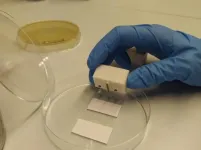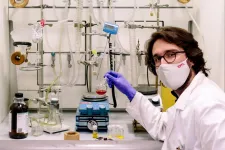(Press-News.org) The Research Group on Synthetic Biology for Biomedical Applications at Pompeu Fabra University in Barcelona, Spain, has designed a cellular device capable of computing by printing cells on paper. For the first time, they have developed a living device that could be used outside the laboratory without a specialist, and it could be produced on an industrial scale at low cost. The study is published in Nature Communications and was carried out by Sira Mogas-Díez, Eva Gonzalez-Flo and Javier Macía.
We currently have many electronic devices available to us such as computers and tablets whose computing power is highly efficient. But, despite their power, they are very limited devices for detecting biological markers, such as those that indicate the presence of a disease. For this reason, a few years ago "biological computers" began to be developed, in other words, living cellular devices that can detect multiple markers and generate complex responses. In them, the researchers leverage biological receptors that allow detecting exogenous signals and, by means of synthetic biology, modify them to emit a response in accordance with the information they detect.
So far, cellular devices have been developed that must operate in the laboratory, for a limited time, under specific conditions, and must be handled by a specialist in molecular biology. Now, a team of researchers from Pompeu Fabra University has developed new technology to "print" cellular devices on paper that can be used outside the laboratory.
Interestingly, they use "ink" of different cell types with nutrients to "draw" the circuits. The cells remain trapped in the paper, alive and functional, and there, they continue growing and are able to release signals that travel through the paper and reach other cells. The reason for doing this on paper (or other surfaces such as fabrics) is principally practical; it is cheap and easy to adapt to industrial use, and large quantities could be produced at a very low cost. "We wanted to design a scalable model and we thought about using a printing system like the one for printing T-shirts", details Sira Mogas-Díez, first author of the study. "We make moulds with our drawing, we soak it with the different cellular inks like a buffer, put it on paper and the cells are deposited", she adds. One strong point is that these devices on paper can be kept in the refrigerator or can even be frozen, since the cellular ink incorporates cryoprotectors that so permit. Thus, unlike previous devices, they can be stored for long periods of time before use.
In this new approach, each element of the device is a group of cells, in this case bacteria, with minimal genetic modifications that can detect different signals. The cells live in the strip of paper and communicate with each other, integrate signals and generate one response or another depending on the different combinations of signals detected. The elements do not vary, but changing their arrangement in space by means of the drawing they make on paper, devices can be built with different functionalities. "Therefore, the order in which the cells are placed is the software, the cells are the hardware, and the paper is the physical substrate hosting these cells", Javier Macía, coordinator of the work, illustrates.
The research team has designed various biosensors, one with a specific application to detect mercury. The system's contribution compared to other existing ones is that it makes a visual estimate of the concentration of mercury without requiring a device in the laboratory that measures it. Depending on the amount of mercury present, more or less dots appear on the reactive strip that can be counted with the naked eye.
Another application being developed is based on detecting cholera in polluted water. "Settlements where there is a risk of cholera often do not have a laboratory or a specialist. Hence, our idea was to develop a new method that would allow us to get living technology outside the laboratory and use it in the field. Our approach is interesting to tackle this kind of problem because it is inexpensive and enables the production of cellular devices in industrial quantities", Sira explains.
Another potential use would be to identify, for example, the risk of preeclampsia. Its detection depends not only on a single marker but a complex combination of markers. A strip with the cellular device with the appropriate configuration could detect biomarker combinations, analyse them and determine a pregnant woman's risk of suffering from this disease.
"Certainly there is much work to do, but these initial results suggest that the methodology developed may be the means to facilitate the creation of commercial products based on living devices", Javier Macía concludes.
INFORMATION:
Reference article:
Mogas-Díez, S., Gonzalez-Flo, E. & Macía, J. 2D printed multicellular devices performing digital and analogue computation. Nat Commun 12, 1679 (2021). DOI: 10.1038/s41467-021-21967-x.
DALLAS, March 19, 2021 -- Mechanical removal of blood clots causing a stroke is increasing, yet racial differences in treatment persist, according to late-breaking science presented today at the American Stroke Association's International Stroke Conference 2021. The virtual meeting is March 17-19, 2021 and is a world premier meeting for researchers and clinicians dedicated to the science of stroke and brain health.
Mechanical clot-removal or endovascular therapy is a non-surgical treatment that uses tiny tubes, or catheters, to remove a blood clot. In 2015, several major clinical trials confirmed that endovascular therapy ...
In Brazil, researchers affiliated with the Center for Nuclear Energy in Agriculture (CENA) and the Luiz de Queiroz College of Agriculture (ESALQ), both part of the University of São Paulo (USP), have developed a methodology based on artificial intelligence to automate and streamline seed quality analysis, a process required by law and currently done manually by analysts accredited with the Ministry of Agriculture.
The group used light-based technology like that deployed in plant and cosmetics analysis to acquire images of the seeds. They then turned to machine learning to automate the image interpretation ...
DALLAS, March 19, 2021 -- New research found patients hospitalized with COVID-19 had a higher risk of stroke, compared with patients who had similar infectious conditions such as influenza and sepsis in prior studies. Those who had an ischemic stroke were more likely to be older, male, Black race, or have high blood pressure, Type 2 diabetes or an irregular heartbeat (atrial fibrillation) compared with other COVID-19 patients, according to late-breaking science presented today at the American Stroke Association's International Stroke Conference 2021. The meeting is being held virtually, March 17-19, 2021 and is a world premier meeting for researchers and clinicians dedicated ...
Schizophrenia and personality disorders are the most disabling mental health conditions to live with, according to scientists from The University of Queensland.
A Danish-Australian research team studied a cohort of 6.9 million Danish residents in the Danish Psychiatric Central Research Register to understand the burden of disability associated with 18 mental and substance use disorders.
Professor John McGrath from UQ Queensland Brain Institute's and the Queensland Centre for Mental Health Research said the data was used to develop a new method for measuring disability that took comorbidities into account.
"Traditionally the impact of mental disorders has been presented for an entire nation, ...
Key takeaways
Nearly half of gastrointestinal cancer operations in this study were performed at 42 U.S. News & World Report "Best Hospitals."
These top-ranked hospitals performed more than four times the annual case volume of unranked hospitals.
Higher hospital case volume was associated with better outcomes, even after accounting for patient characteristics and complicating factors.
Patients with complex gastrointestinal (GI) cancers may fare better by seeking surgical care at high-volume, top-ranked hospitals.
CHICAGO (March 19, 2021, 9 a.m. CDT): A new study reinforces the principle that "practice makes perfect" ...
The combination of cancer therapy lenalidomide plus the steroid dexamethasone (together called Rd) is considered standard treatment for elderly patients with multiple myeloma. However, prolonged steroid use can be harmful for some older adults.
A new study published in Blood found that switching select older patients to a lower dose of lenalidomide and discontinuing dexamethasone after nine months was not only safe, but it also yielded similar outcomes as compared with patients who received continuous Rd.
Multiple myeloma, a cancer affecting the blood plasma cells (a type of white blood cell in the bone marrow), most commonly ...
3,938 moths are part of a major insect study based on artificial intelligence, and researchers from Aarhus University have just published their results in the scientific journal Sensors.
They have developed a counting machine that uses ultraviolet light to attract insects and register them with image recognition. The invention may have a decisive impact on research into climate change and biodiversity.
"If we can monitor the development of moth populations, we can gain new knowledge about how climate change affects our nature. Our technology takes an important step towards automating the very extensive work entailed in counting insects," ...
We all feel physical pain in different ways, but people with nerve injuries often have a dysfunctional pain suppression system, making them particularly prone to discomfort.
Now researchers have uncovered that virtual reality (VR) can reduce types of pain typically seen in patients with nerve injuries - and that VR can boost the dysfunctional pain suppression system, giving people with chronic pain a possible game-changing hope.
Dr Sam Hughes, Lecturer in Psychology at the University of Plymouth, led the study focusing on conditioned pain modulation ...
In 1991, scientists Brian O'Regan and Michael Grätzel at EPFL published a seminal paper describing a new type of solar cell: the dye-sensitized solar cell (DSSC), also known as "Grätzel cell". Simple and cheap to build while being flexible and versatile, DSSCs are already manufactured on a multi-megawatt scale, cutting a significant slice of the photovoltaic market, which currently supplies almost 3% of all the world's electricity, well in the race to reduce carbon emissions.
Now, Dan Zhang and Marko Stojanovic, two PhD students in Grätzel's lab at EPFL's School of Basic Sciences, have led the development of a simple dye for DSSCs, called MS5. In devices, this new sensitizer can either be used as single dye, ...
Researchers from Tomsk Polytechnic University jointly with their colleagues from the Czech Republic have found a method to synthesize cyclic carbonates from atmospheric CO2. Cyclic carbonates are organic compounds, used as electrolytes for lithium-ion batteries, green solvents as well as in pharmaceutical drugs manufacturing. The scientists managed to synthetize carbonates under sunlight and at room temperature, while conventional methods require synthesis under high pressure and temperatures. The research findings are published in Journal of Materials Chemistry A (IF:11,301; Q1).
"The increase in CO2 levels in the atmosphere is a global environmental problem. The solutions of the problem are usually focused on measures to reduce CO2 emissions. An alternative method is to use the CO2 already ...


